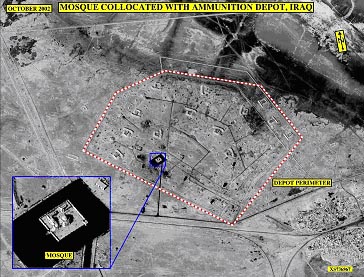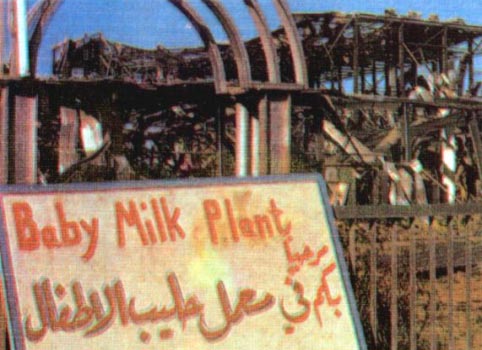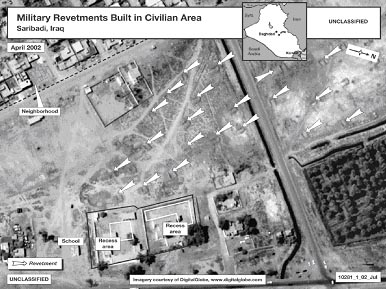|
Home >
Government >
Global Communications
|
|
Crafting Tragedy
[ « Previous || Next » ]
|
"The presence or movements of the civilian population or individual civilians shall not be used to
render certain points or areas immune from military operations, in particular in attempts to shield
military objectives from attacks or to shield, favour or impede military operations. The parties to
the conflict shall not direct the movement of the civilian population or individual civilians in order
to shield military objectives from attacks or to shield military operations." – Protocol to the Geneva Conventions of 1949, Article 51 |
Based on what he has done in the past, if conflict with Iraq should occur, Saddam is almost certain to lay a trap for the world’s media. He apparently believes that dead Iraqi civilians are his most powerful weapon in trying to create revulsion against any military action that might occur against Iraq.
During Operation Desert Storm, the coalition chose its targets carefully and had strict rules of engagement intended to avoid bombing innocent civilians. Even with careful targeting, fire discipline, and the well-known use of precision munitions in the campaign, some civilian casualties occurred. Saddam Hussein used deaths of innocent civilians to try to undermine international and domestic support for the American-led coalition, and the Iraqi regime made many claims that civilian targets had been hit by coalition air forces, with loss of innocent civilian lives.

The Iraqi regime's propaganda campaign went far beyond normally-expected protests over civilian casualties. The Iraqis quickly realized that placing military assets – including tanks, missiles, and command-and-control facilities – close to civilians and civilian infrastructure could yield substantial benefits. By shielding military assets with civilians and civilian infrastructure, Saddam understood that coalition forces would either avoid attacking targets close to civilians or risk severe political damage from unintended civilian deaths at what would have appeared to be a purely military site.
The co-location strategy has three objectives:
- To conceal military assets;
- To deter coalition attacks on military assets that could not be concealed; and
- Failing the first two objectives, to capitalize on attacks by generating civilian casualties and destruction of cultural sites.
Some of the regime's co-locations were clearly detectable through overhead imagery. Those that were not yielded tragic results – and a rich vein of propaganda. This is a long-standing practice: Throughout the country, the Iraqi government continues to locate military assets close to or together with civilian facilities and cultural sites, and it continues to build new mosques and other civilian facilities in or near military areas.
Iraqi Co-Locations of Military and Civilians. Then...
CNN reporter Peter Arnett wrote that one night during the Gulf War a SCUD missile and launcher appeared
on the front lawn of the Al-Rashid Hotel, where he and other journalists were staying.2
In 1990, the international press widely reported that Iraq had held more than 1,000 Western and Japanese men, women, and children as human shields at about 70 sites in Iraq, including air force bases, military garrisons, weapons factories, and power plants before eventually releasing them under international pressure.
During the Gulf War, the Iraqi regime placed two military aircraft next to the ancient Ur ziggurat near Tallil, Iraq. A coalition strike on the aircraft could well have caused extensive damage to this ancient Mesopotamian cultural treasure.
When coalition leaders publicly stated that religious sites would not be targeted, Saddam began using these sites to shield military equipment and units. In other cases, dual use facilities were exploited for propaganda value.

On January 21, 1991, coalition bombers hit what the Iraqis claimed was a "baby milk factory" in Baghdad. The United States insisted that Iraq was using it as a biological-weapons development site. It appears the facility had briefly functioned as a "baby milk" factory in 1979 and 1980, and then again in the spring and summer of 1990, before the Iraqi regime began to use it as a biological weapons site.
As U.S. officials pointed out at the time, the Iraqi regime was defending the site as it would a military facility. After the Gulf War, UNSCOM inspectors discovered that three scientists from the Iraqi regime's main biological weapons facility had been assigned to the "baby milk" factory.
 Journalists who were taken to the "baby milk" factory in 1991 saw this hand-lettered sign in English and Arabic.
Journalists who were taken to the "baby milk" factory in 1991 saw this hand-lettered sign in English and Arabic.
|
...And Now.
Since the Gulf War, the Iraqis regularly have placed Air Defense missile systems and associated equipment
in and around numerous civilian areas including parks, mosques, hospitals, hotels, crowded shopping districts,
ancient cultural and religious sites, and even cemeteries. They have placed rocket launchers next to soccer
stadiums that were in active use, parked operational SAM systems in civilian industrial centers.
In late 1997, the Iraqi regime made sure the world media filmed Iraqi civilians, including women and children, at military and industrial sites. The U.S. government later learned that it then secretly replaced the civilians with prisoners, who were mostly opposition figures but also included some criminals. If the sites had been attacked, the Iraqi regime was poised to claim that any prisoners killed were the Iraqi civilians who had previously been there.
In April 2002, commercial satellite imagery showed that the Iraqis had constructed 15 military revetments near a school in Saribadi, a town 31 miles southeast of Baghdad. Some of the revetments, essentially holes in which military vehicles are parked as protective measures against air strikes, are less than 11 yards from the wall surrounding the school.
 Military revetments (arrows) in civilian area of Saribadi, April 2002.
Military revetments (arrows) in civilian area of Saribadi, April 2002.
|
In 2002, the United States government learned that the Iraqi government had ordered taxis and buses to be repainted with military colors in order to look like military vehicles.
On January 8, 2003, the Associated Press and others reported that Iraqi Deputy Prime Minister Tareq Aziz welcomed foreign volunteers to come to Iraq and serve as human shields around civilian facilities in the event of armed conflict, thereby planting the idea that civilian facilities would be subject to attack. Iraq issued similar calls for volunteers in 1990. In the event of conflict, such human shields would most likely be deployed around military targets – either to deter strikes against the targets or to create casualties in the event of their being struck.
|
|||
 Visitors tour the Amiriyah Bunker. The Iraqi government has preserved the bunker as a public memorial.
Visitors tour the Amiriyah Bunker. The Iraqi government has preserved the bunker as a public memorial.
|
[ « Previous || Next » ]
|
|
|
President
|
Vice President
|
First Lady
|
Mrs. Cheney
|
News & Policies
|
|

